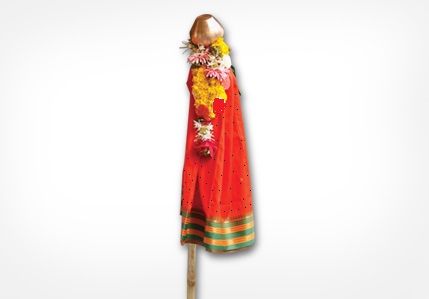Gudi Padwa is the most auspicious occasion, a holy festival and a new year for Maharashtrian people. This day is usually celebrated on the first day of Hindu Lunar month of Chaitra. Gudi Padwa is very special festival for my family and it is celebrated in a special way.

Importance of Gudi Padwa
Many stories and events are related to Gudi Padwa and in order of remembrance this auspicious festival is usually celebrated.
It is believed that on this auspicious occasion, Lord Brahma recreated the Universe from massive destruction and chaos. Hence Gudi Padwa is celebrated in the remembrance of innumerable Lords.
It is also believed that on this day Lord Rama returned Ayodhya after defeating or killing Ravan and his allies. Hence people of Ayodhya celebrated this day and considered as the beginning of new era.
Gudi Padwa Rituals
Holy Bath and Decoration
A day prior to Gudi Pawda, people start cleaning the house. On this day, it is a custom to wake up early in the morning, and take oil massage and then warm water bath. Oil makes our body soft and elastic once it is absorbed and warm water after the massage pleases our body. Women wear beautiful nine yard saree, also called as 'Navari' saree while kurta pajama and turban are the famous outfit in men during Gudi Padwa. Women and girls draw colorful rangolis in front of the door or house. My family also make use of small lamps or 'diva' to maker rangoli more beautiful and attractive. Also every house door are decorated with flowers or garland or' toran' in marathi. Most of the Maharashtrian people use flowers for every festival to decorate their homes as flowers signifies fragrance and purity which makes the home pure and full of positive energy.
Gudi
Once the house is decorated we start focusing on making the Gudi. The Gudi is basically a bronze Kalash that is placed upside down on a wooden stick. Swastik is made on the Kalash using turmeric and vermillon. Wooden stick is usually covered with bright red or yellow color cloth that looks like a saree. Along with Gudi, a garland made of neem leaves and sugar candy are hung. This garland signifies the bitterness and sorrow of our life, neem being sour in taste while sugar resembles sweetness. This Gudi is then placed tilted at an angle near the doorway or near the window. After placing the Gudi, people offer the flowers, perform aarti and distribute the prasad made of Neem and jaggery or sugar.
Special Dish
On this occasion a special dish is prepared called 'Puran Poli' which consists of paste made from bengal gram (chana dal), sugar or jaggery filled into wheat roti. Then it is prepared as we prepare roti. Some people make sugar and jaagery syrup so that you can eat puran poli by dpping into the syrup. In my family, we prepare both sweet syrup and spicy curry along with Puran Poli. This is the most delicious dish I have ever come across and I can eat it anytime anywhere.
Along with Puran Poli, we also prepare dal and rice, salad, potato vegetable, and kheer. This becomes a complete dish during Gudi Padwa.
This auspicious day ends with the evening dinner and in the remembrance of god for saving us from the disaster and for the beginning of new era.